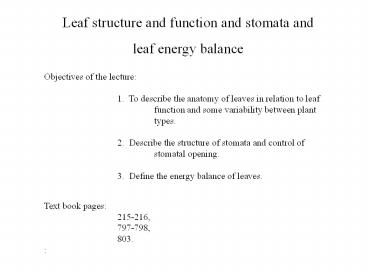Leaf structure and function and stomata and leaf energy balance - PowerPoint PPT Presentation
Title:
Leaf structure and function and stomata and leaf energy balance
Description:
Leaf structure and function and stomata and leaf energy balance Objectives of the lecture: 1. To describe the anatomy of leaves in relation to leaf function and some ... – PowerPoint PPT presentation
Number of Views:437
Avg rating:3.0/5.0
Title: Leaf structure and function and stomata and leaf energy balance
1
Leaf structure and function and stomata and leaf
energy balance
Objectives of the lecture 1. To describe
the anatomy of leaves in relation to leaf
function and some variability between plant
types. 2. Describe the structure of
stomata and control of stomatal opening. 3.
Define the energy balance of leaves.
Text book pages 215-216, 797-798, 803.
2
Figure 23-8
Recall ...
Apical meristems are located at specific
points throughout the body.
Close-up of a shoot apical meristem
Shoot meristems
Developing leaves
Rapidly dividing, undifferentiated meristematic
cells
Cells differentiating into ground tissue
Cells differentiating into vascular tissue
Cells differentiating into epidermal tissue
Root meristems
3
Figure 36-11
Simple leaves have a petiole and a single
blade.
Species from very cold or hot climates have
needle-like leaves.
Doubly compound leaves are large yet rarely
damaged by wind or rain.
Compound leaves have blades divided into
leaflets.
Blade
Petiole
Figure 36-12
Opposite leaves
Alternate leaves
Rosette
Whorled leaves
4
Diagram of a dicot leaf
5
Tomato leaf, dicotyledon, C3 plant
6
Leaf cross section of Zea mays (corn),
monocotyledon, C4 plant
7
Leaf of a dictyledon
Typically veins are distributed such that
mesophyll cells are close to a vein.
The network of veins also provides a supportive
framework for the leaf.
8
Leaf of a monocotyledon plant
The major venation follows the long axis of the
leaf and there are numerous joining cross veins
so that, as with the dicotyledon, mesophyll cells
are always close to a vein.
9
Leaf cross section of a conifer, Taxus (yew)
The mesophyll is differentiated into palisade
and spongy layers
10
Figure 10-21
Leaf surfaces contain stomata.
Leaf surface
Guard cells
Pore
Stoma
Carbon dioxide diffuses into leaves through
stomata.
Interior of leaf
O2
H2O
Leaf surface
CO2
Extracellular space
Photosynthetic cells
Stoma
11
Structure of stomata
Epidermal cell
Guard cell
Nucleus
Stoma
Vacuole
Thickened wall
Chloroplast
12
Physiological control of stomatal opening and
closing
Guard cells actively take up K causing water to
enter by osmosis. The guard cells walls are
unevenly thickened causing the cells to bow as
they becomes turgid
Variation between species in stomatal
control isohydric, maintains constant leaf
water potential, maize, poplar anisohydric,
leaf water potential decreases during day,
sunflower, barley.
13
The energy budget of foliage
Radiation input
Some radiation is reflected and some energy is
re-radiated
If Tleaf gt Tair then the leaf warms the air
The leaf boundary layer is important in
controlling heat exchange and transpiration
Evaporative cooling of the leaf depends upon
latent heat of evaporation
14
Wind speed influences transpiration
The boundary layer around a leaf extends out
from the leaf surface. In it air movement is
less than in the surrounding air. It is thick in
still air, and constitutes a major resistance to
the flux of H2O from the leaf.
A slight increase in wind speed will reduce the
boundary layer, and increase transpiration.
Further increase in wind speed may reduce
transpiration, especially for sunlit leaves,
because wind speed will cool the leaf directly
15
Thermal images of non-transpiring leaves of
sycamore and oak. Conditions during measurement
wind speed 0.6 m s-1, air temperature
30.2 oC, photo flux density 910 ? mol m-2 s-1
16
Laboratory measurement of transpiration
A laboratory potometer
1. Fill the potometer by submerging it make
sure there are no air bubbles in the system.
2. Recut the branch stem under water and,
keeping the cut end and the potometer under
water, put the cut end into the plastic tubing.
17
Figure 36-13
Grown in shade
Grown in sun
Leaf plasticity in response to variation in
light Sun leaves are smaller in area (0.5-0.6)
than shade leaves Sun leaves have 1.5 to 2.2
leaf mass/area than shade leaves Sun leaves
have up to 1.5 the density of stomata than shade
leaves Sun leaves have more Rubisco per unit
chlorophyll Sun leaves have less chlorophyll per
reaction center
18
Coastal redwood Sequoia sempervirens
Plasticity in foliage in relation to water
deficits
Ability to transport water to 125m depends upon
wood structure
Reiteration of foliage from existing branch
structure
Koch et al. 2004. Nature 428, 851-854
19
In Taxus caespitosa and other conifers stomata
are arranged in rows
20
Figure 37-16
Oleander
Adaptation of a xerophyte
Cross section of oleander leaf
Waxy cuticle on upper surface of leaf
is especially thick
Epidermis
Vascular bundles
Palisade mesophyll
Air space
Stomata
Spongy mesophyll
Epidermis
Epidermis
Epidermis
Epidermal hairs
Stomata are located in crypts instead of on
flat leaf surface
21
Things you need to know ...
1. The anatomy of leaves and variations between
dicotyledons, monocotyledons and conifers.
2. What a stoma is and UNDERSTAND how stomatal
opening is controlled and what effect it can
have on transpiration.
3. Basic aspects of leaf energy budget.
UNDERSTAND what the components are and how they
can be affected by environmental variation in
radiation input, air temperature, and wind speed,
and leaf shape.
4. What is meant by leaf plasticity and how it
can be a response to variation in light
conditions and leaf water status.

